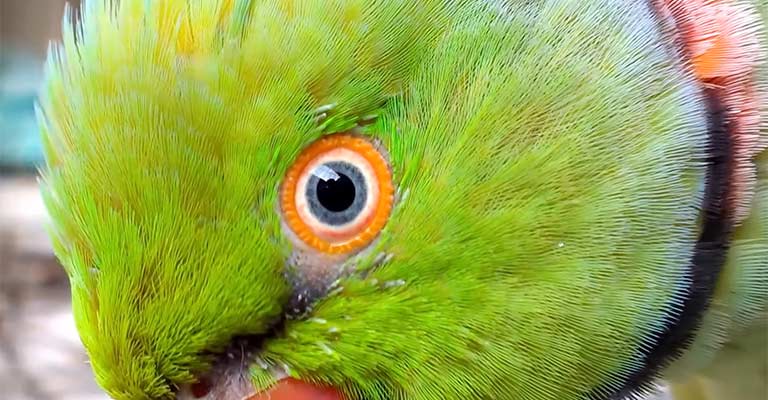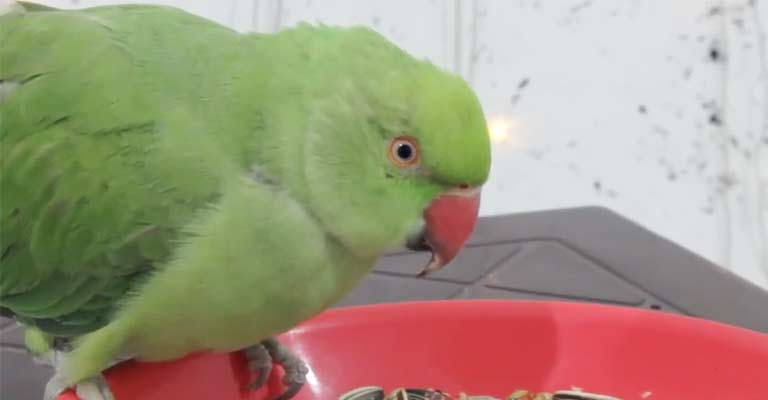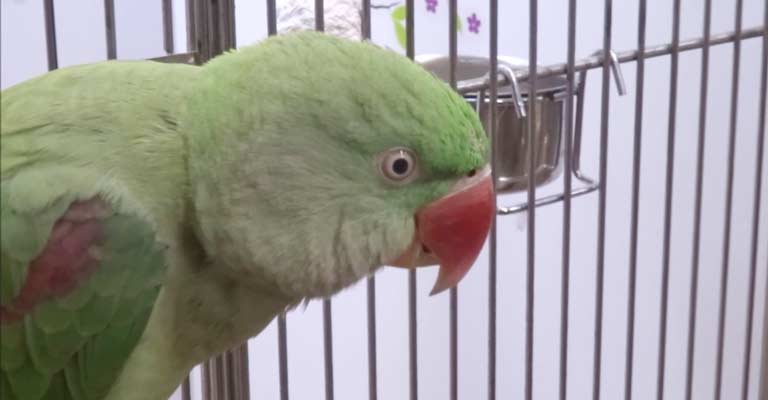In the captivating world of avian intelligence, parrots stand as feathered marvels, captivating both scientists and enthusiasts alike.
Beyond their vibrant plumage and articulate mimicry, parrots exhibit a fascinating phenomenon – the dilation of their eyes.
This subtle yet intriguing behavior has sparked curiosity among bird aficionados and researchers, prompting the question: Why do parrots’ eyes dilate? Delving into the intricate interplay of biology and behavior, this exploration aims to unravel the secrets behind this avian ocular adaptation.
From deciphering its potential role in communication to understanding the influence of environmental stimuli, join us on a journey into the kaleidoscopic gaze of these charismatic birds.
As we peer into the kaleidoscope of parrot eyes, we embark on a quest to decode the language written in their dilating pupils and uncover the hidden facets of their visual expressions.

Why Do Parrots’ Eyes Dilate?
Parrots, like many other creatures, have eyes that dilate and constrict in response to varying light conditions.
However, unlike some species where this primarily serves the purpose of regulating the amount of light entering the eyes, in parrots, eye dilation extends beyond a mere physiological response.
It becomes a language, a non-verbal expression of their emotions and responses to the world around them.
Unraveling the Mystery
To comprehend why parrots’ eyes dilate, we must first delve into the intricate interplay of biology and behavior. Research suggests that akin to humans, parrots experience emotional states, and these states are often reflected in the size of their pupils.
Dilated pupils might indicate excitement, curiosity, or heightened interest, while constricted pupils could signify fear, stress, or displeasure.
The Language of Pupils
Parrots are known for their social nature and complex communication skills. Their eyes, with their ability to rapidly change size, contribute significantly to this intricate system of avian communication.
For instance, during moments of interaction, a parrot may display dilated pupils, signifying enthusiasm or engagement. This visual cue is crucial within flocks, allowing individuals to convey their intentions and emotions without vocalizing.
Adaptation to Environment
While emotional expression plays a role in why parrots’ eyes dilate, environmental factors also come into play. In the wild, parrots inhabit diverse ecosystems, from dense rainforests to arid savannahs.
The ability to quickly adjust pupil size aids them in adapting to varying light conditions. Whether navigating the dappled sunlight of a forest canopy or the harsh brightness of an open landscape, the dynamic nature of their pupils ensures optimal vision.
Light and Dark: A Visual Symphony
Parrots are crepuscular beings, meaning they are most active during dawn and dusk. This behavioral trait aligns with the dynamic changes in light during these transitional periods.
The dilation of their eyes during low light conditions enhances their ability to navigate and forage, highlighting the evolutionary significance of this adaptation.
Emotional Intelligence in the Avian Realm

Beyond survival instincts and environmental adaptation, parrots’ eye dilation serves as a testament to their emotional intelligence. Studies have shown that these birds form deep bonds with their human companions, often mirroring emotions and responding to changes in the household atmosphere.
The dilating pupils become a canvas upon which their emotional responses are painted, creating an unspoken connection between the parrot and the caregiver.
Individual Variations
Just as humans exhibit unique emotional responses, parrots, too, showcase individual variations in their eye dilation patterns. Factors such as age, health, and past experiences can influence the extent to which a parrot’s pupils dilate.
Understanding these nuances enhances our ability to comprehend the intricacies of their emotional lives and strengthens the bond between humans and their feathered friends.
The Role of Trust
In the realm of parrot-human interactions, trust plays a pivotal role. Observing a parrot’s eyes dilate during human interaction signifies a level of comfort and trust in their human companions.
This nuanced communication fosters a deeper connection, as the parrot perceives the human as a source of security and positive experiences.
Challenges in Decoding
While significant strides have been made in deciphering the reasons behind parrots’ eye dilation, challenges persist. The intricate nature of avian behavior, coupled with individual variations, makes it a complex puzzle for researchers.
Continued studies and observations are essential to unravel the remaining mysteries and gain a comprehensive understanding of this captivating aspect of parrot physiology and behavior.
Conservation Implications
Understanding the language of parrot eyes not only enhances our appreciation for these intelligent birds but also holds implications for conservation efforts.
As human activities encroach upon natural habitats, decoding the visual expressions of parrots can aid in assessing their well-being and adapting conservation strategies to mitigate the impact of environmental changes.
Importance of Gaze for the Parrot

The gaze of a parrot holds profound significance in its world, extending far beyond a mere visual function.
These avian companions, known for their vibrant personalities and complex communication skills, rely heavily on their gaze to navigate social interactions, convey emotions, and establish connections within their flock or with their human caregivers.
Social Bonds and Communication
Parrots are inherently social beings, forming intricate bonds within their flocks and, in domestic settings, with their human companions.
The gaze serves as a powerful tool for communication, allowing them to convey a myriad of emotions and intentions without vocalizing.
Through eye contact, a parrot can express curiosity, trust, excitement, or even a sense of reassurance.
This visual language plays a crucial role in maintaining social harmony within a group, enabling parrots to understand and respond to the emotions of their fellow flock members.
Trust and Bonding
In the realm of parrot-human interactions, establishing trust is paramount. The gaze becomes a key element in building and reinforcing this trust. When a parrot looks directly into the eyes of its caregiver, it signifies a level of comfort and security.
This mutual gaze fosters a deeper connection, strengthening the bond between humans and parrots. Over time, as trust deepens, the parrot may seek and maintain eye contact as a form of companionship, recognizing the caregiver as a source of safety and positive experiences.
Emotional Expression
The expressive capabilities of a parrot’s gaze extend to the realm of emotional expression. Dilated pupils, for instance, can indicate excitement, engagement, or heightened interest.
Conversely, constricted pupils may signal fear, stress, or discomfort. By closely observing the nuances of their gaze, caregivers can gain insights into the emotional well-being of their feathered companions.
This heightened emotional intelligence contributes to a more enriched and responsive relationship between humans and parrots.
Navigation and Awareness
In the wild, parrots inhabit diverse environments, ranging from dense forests to open landscapes. The gaze plays a crucial role in their ability to navigate and remain aware of their surroundings.
By monitoring changes in light and shadows, parrots can identify potential threats or opportunities.
The dynamic nature of their pupils, capable of rapid dilation and constriction, aids in adapting to various light conditions, enhancing their visual acuity during dawn and dusk when they are most active.
Learning and Imitation
Parrots are renowned for their impressive ability to mimic human speech and behaviors. The gaze becomes a tool for observational learning. By closely watching the actions and expressions of those around them, parrots can acquire new behaviors and language cues.
This observational learning, coupled with their innate communication skills, allows them to integrate seamlessly into human households, often adopting the habits and expressions of their human caregivers.
Challenges and Misunderstandings
While the gaze is a powerful means of communication for parrots, misinterpretations can occur. For instance, a prolonged direct stare may be perceived as a threat in the avian world.
Understanding the context and combining visual cues with other forms of communication, such as vocalizations and body language, is essential for caregivers to accurately interpret a parrot’s intentions.
Building a strong bond and trust with the parrot helps in navigating these potential misunderstandings.
Conservation Implications
The importance of the gaze extends beyond individual interactions; it holds implications for parrot conservation efforts.
Understanding the role of visual communication in parrot societies can aid researchers in developing strategies to support the well-being of these birds in both natural and captive environments.
Conservation initiatives can benefit from considering the social and communicative aspects of parrot behavior, ensuring that efforts to protect these species address their complex social needs.
FAQs
Why do parrots’ eyes dilate?
Parrots’ eyes dilate as a response to emotional states and varying light conditions. It serves as a form of communication, indicating excitement, curiosity, or even trust.
How can I build trust with my parrot through eye contact?
Building trust with your parrot involves maintaining gentle and consistent eye contact, allowing the bird to become familiar with your presence. Slow blinking and positive interactions reinforce a sense of security.
Do all parrot species exhibit the same eye dilation behaviors?
While the basic function of eye dilation is common across parrot species, individual variations exist. Factors such as age, health, and past experiences can influence the extent and frequency of eye dilation.
What role does a parrot’s gaze play in its ability to mimic human speech?
The parrot’s gaze contributes to observational learning, a crucial aspect of their ability to mimic. By closely watching their human companions, parrots can learn and replicate both verbal and non-verbal behaviors.
Are there potential misinterpretations of a parrot’s gaze, and how can they be avoided?
Yes, prolonged direct stares may be perceived as threatening in the parrot world. Caregivers should be aware of contextual cues, combine visual observations with other forms of communication, and foster a trusting relationship to avoid misunderstandings.
Conclusion
In the pursuit of understanding why parrots’ eyes dilate, we have traversed the realms of avian cognition and communication. The dilation of their eyes, once a cryptic enigma, emerges as a nuanced facet of their expressive repertoire.
As we conclude this exploration, it becomes apparent that these dilating pupils serve as dynamic windows into the parrot psyche, responding not only to shifts in light but also mirroring emotional states.
From moments of heightened curiosity to expressions of contentment or even caution, the kaleidoscopic dance of their pupils encapsulates a language beyond words.
This revelation prompts us to appreciate the intricate ways in which parrots communicate and adapt to their surroundings.
The mystery of their dilating eyes, while partially unveiled, leaves room for further inquiry, inviting us to delve deeper into the awe-inspiring world of these intelligent and perceptive avian companions.